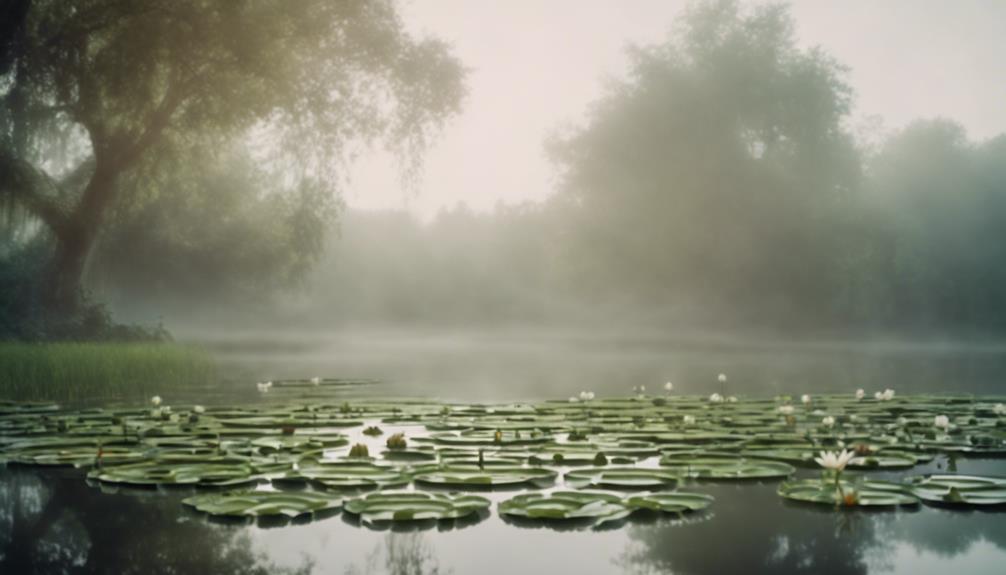You're probably wondering why algae grow in your pond. The truth is, they're a natural and essential part of the aquatic ecosystem, providing food for species at the lower end of the food chain. However, excessive growth can be influenced by factors like excess nutrients, light, and temperature. When these factors are out of balance, algae can overgrow, disrupting the ecosystem. You may be inadvertently contributing to the problem by overfeeding fish or allowing nutrient-rich runoff into the pond. Now that you know the basics, you're one step closer to understanding the complexities of algae growth and how to manage it effectively.
Table of Contents
Key Takeaways
- Algae grow in ponds when essential nutrients like phosphorus and nitrogen are present in excess, stimulating their growth.
- Nutrient imbalances and climate factors, such as warm water and abundant sunlight, contribute to algae growth.
- Overfeeding fish and stormwater runoff can introduce excess nutrients, leading to algae blooms.
- Insufficient aquatic plants and poor water circulation can create an ideal environment for algae growth.
- Decomposing organic matter and nutrient-rich runoff from fertilizers and septic systems can fuel algae growth.
Understanding Algae in Ponds
As you observe your pond, it's vital to acknowledge that algae are a natural and integral component of any thriving aquatic ecosystem.
They provide essential food for species at the lower end of the food chain, contributing to a well-balanced ecosystem.
In fact, a small amount of algae in your water feature is a sign of a healthy ecosystem.
You'll notice two main types of algae: suspended algae, which reproduce rapidly, turning the water green and cloudy, and string algae, often found attached to surfaces in the water feature.
Algae growth is influenced by various factors, including light, temperature, nutrient type, animal grazers, and pathogens.
Different algae species thrive in different ponds due to varying habitat and conditions.
The key is to understand that algae growth is a natural process, and your goal should be to keep it in balance with nature, not to completely eliminate it.
Causes of Excessive Algae Growth
As you investigate the causes of excessive algae growth in your pond, you'll likely find that nutrient imbalances and climate factors are key contributors to the problem.
You'll want to examine the levels of phosphorus and nitrogen in your water, as well as the impact of sunlight and temperature fluctuations on algae growth.
Nutrient Imbalance
One key factor contributing to excessive algae growth in your pond is an imbalance of essential nutrients, particularly phosphorus and nitrogen, which can have a profound impact on the ecosystem.
When these nutrients are present in excess, they can stimulate algae growth, leading to an imbalance in the ecosystem.
You may be inadvertently contributing to this imbalance by overfeeding your fish, as excess food can decay and release phosphorus and nitrogen into the water. Additionally, stormwater runoff can carry these nutrients into your pond, further fueling algae growth.
If you don't have a proper pond filtration system in place, these excess nutrients can accumulate, creating an ideal environment for algae to thrive.
By understanding the role of phosphorus and nitrogen in algae growth, you can take steps to maintain a balanced ecosystem and prevent excessive algae growth.
Climate Factors
Climate factors, including rising global temperatures, altered rain patterns, and changes in light exposure, are contributing to the ideal conditions for excessive algae growth in your pond.
Rising temperatures sustain blue-green algae blooms into fall or winter months, allowing them to grow for a longer period.
Changes in rain patterns lead to more erosion and runoff, bringing more soil nutrients into water systems and fueling excessive algae growth.
Changes in light exposure allow blue-green algae to flourish, and light fluctuations underneath the surface of pond water create perfect conditions for cyanobacteria growth.
You may be wondering how these factors impact your pond's ecosystem.
As a pond owner, mastering how these climate factors interact with your pond's unique conditions, such as water temperatures, is vital to create an environment conducive to algae growth.
Importance of Aquatic Plants
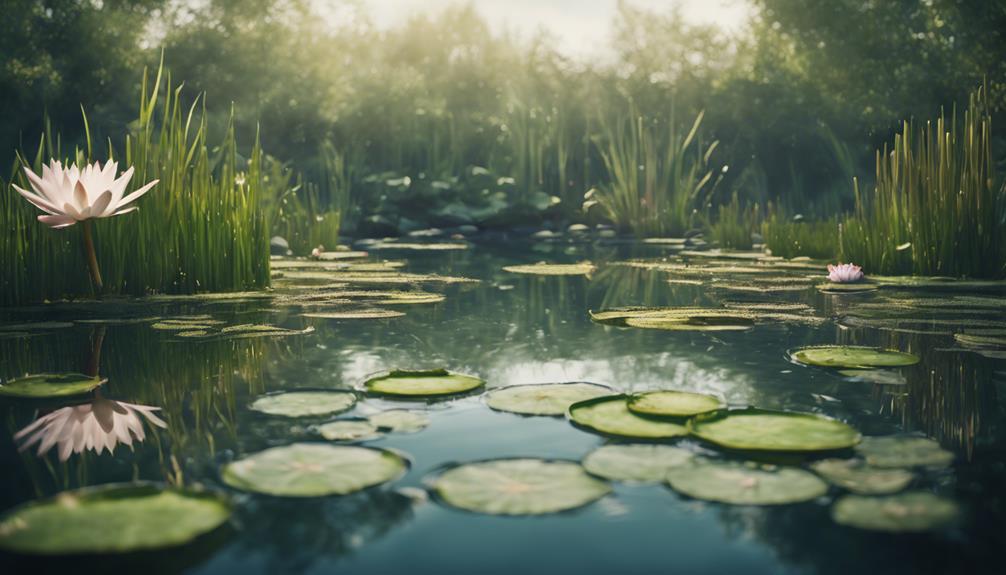
As you work to combat algae growth in your pond, you'll find that aquatic plants are a vital ally.
These plants will compete with algae for essential nutrients, reducing the likelihood of excessive growth.
Reducing Algae Growth
By introducing aquatic plants into your pond, you're taking a pivotal step towards reducing algae growth, as these plants play a key role in competing with algae for nutrients and providing shade. This is especially important in preventing filamentous algae blooms, which can quickly take over your pond.
Plants like water lilies can cover approximately two-thirds of the water's surface, reducing algae growth by limiting sunlight exposure.
Aquatic plants consume excess nutrients, preventing them from fueling algae growth.
Competing for Nutrients
When you introduce aquatic plants into your pond, they immediately start competing with algae for the same essential nutrients, such as nitrogen, phosphorus, and potassium.
This competition is vital, as it limits the amount of nutrients available for algae growth.
Aquatic plants, being more efficient at absorbing nutrients, outcompete algae for these resources.
As a result, algae growth slows down, and the overall water quality improves.
Role of Nutrients in Algae Growth
What sparks the explosive growth of algae in your pond is often an overabundance of nutrients, specifically phosphorus and nitrogen, which serve as the building blocks for algae cells to multiply and thrive. These excess nutrients create an ideal environment for algae growth, allowing them to outcompete other aquatic plants for resources.
Excess nutrients can enter your pond in three ways:
Nutrient-rich runoff: Fertilizers from lawns, agricultural soil, and failing septic systems can flow into your pond, bringing phosphorus and nitrogen with them.
Phosphates from everyday sources: Tap water, plant pots, and decomposing organic matter can all introduce phosphates into your pond, fueling algae growth.
Decomposing matter: As organic matter breaks down, it releases nutrients that algae can use to grow and multiply.
Controlling Algae With Barley Straw
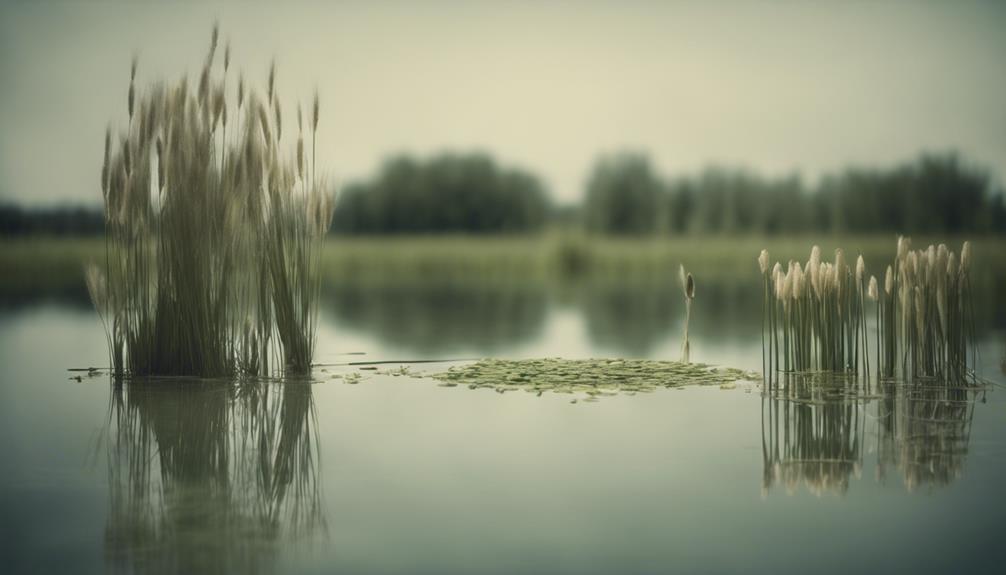
As you consider controlling algae with barley straw, you'll need to understand the proper application, dosage, and timing to achieve effective results.
You'll want to learn how to apply the straw correctly, determine the right dosage for your pond's size, and maintain the straw's effectiveness over time.
Applying Barley Straw
You'll need to add barley straw to your pond at specific times of the year to effectively inhibit algal growth.
To do this correctly, you'll want to apply the straw twice a year, in early spring and autumn, at a rate of 10-50gm per m2 of pond surface area.
Loose straw is best: Make sure the straw is loose and allows water to pass easily through it.
Support the straw: Use floats to prevent the straw from sinking, and consider putting it in a net bag or bundle attached to an anchor in small garden ponds.
Monitor for effectiveness: If the straw starts to smell, it's not working and should be removed, as it's a sign that the treatment isn't controlling algae growth.
Straw Dosage and Timing
To achieve ideal algal control, it is vital to apply barley straw at the correct dosage and timing, as this will substantially impact the treatment's effectiveness.
For optimal results, it's recommended to use 10-50gm of barley straw per m2 of your pond's surface area. Timing is also essential, and you should apply the straw twice a year, in early spring and autumn. This allows the straw to effectively control algae growth during the peak seasons.
When applying the barley straw, make sure it's loose and allows water to pass easily. You can support it with floats to prevent it from sinking, ensuring maximum effectiveness.
If you notice the straw starts to smell, it's not working, and you should remove it, as this indicates the treatment isn't effective in controlling algae growth.
Using barley straw is a convenient and easy-to-use solution, especially for small garden ponds. You can simply put the straw into a net bag or bundle and attach it to an anchor.
Maintaining Straw Effectiveness
By regularly replacing the barley straw and verifying it remains in contact with the water, you can maintain its effectiveness in controlling algae growth in your pond. This natural and environmentally friendly approach requires some attention to guarantee it continues to work effectively.
Check the straw regularly: If it starts to smell, it's not working and should be removed. A foul odor indicates the straw has become anaerobic and is no longer effective in controlling algae.
Replace the straw as needed: Barley straw works by releasing compounds that inhibit the growth of algae. Regular replacement certifies these compounds continue to be released, maintaining the straw's effectiveness.
Verify the straw is in contact with the water: The straw should be loose, allowing water to pass easily, and supported by floats to prevent sinking. This guarantees the straw remains in contact with the water, maximizing its effectiveness in controlling algae growth.
Harmful Effects of Algae Blooms
Excessive algae growth can have devastating consequences for your pond, causing a ripple effect that disrupts the delicate balance of the ecosystem.
As pond algae grows, it can form thick mats and blooms that shade out other plants, reducing biodiversity and ecosystem balance. This can lead to deoxygenation of the water, causing stress and even death to fish and other aquatic organisms.
When these algae blooms decay, they consume even more oxygen, creating a toxic environment for aquatic life. Furthermore, decaying algae can release ammonia and other toxins into the water, further harming your pond's ecosystem.
Blue-green algae, in particular, produce toxins that can poison wildlife, pets, and even humans, making it a significant public health concern.
Uncontrolled algae growth can also clog waterways, impede water flow, and interfere with recreational activities like swimming, fishing, and boating.
Crucially, taking proactive steps to manage pond algae and prevent these harmful effects from occurring is vital.
Treating Algae With UV Clarifiers
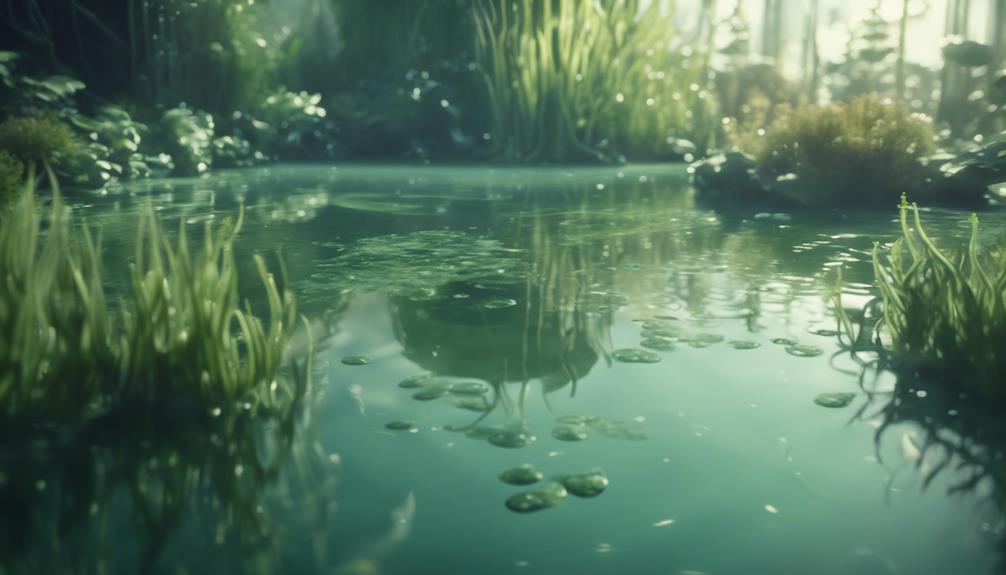
You can take a proactive approach to managing algae growth by utilizing UV clarifiers, which offer a chemical-free solution to restoring your pond's clarity and health. These devices work by exposing algae to a specific wavelength of light that damages their DNA, preventing them from reproducing and eventually killing them.
Effective UV clarifiers can clear up green water in as little as 7-10 days, depending on the severity of the algae bloom and the size of the pond.
Regular cleaning of the unit and replacement of the bulb as needed are vital to guarantee its effectiveness in controlling algae growth.
UV clarifiers provide a safe and environmentally friendly way to manage algae, without introducing harsh chemicals into your pond ecosystem.
Preventing Algae Growth Naturally
To prevent algae growth naturally, maintaining a balanced ecosystem is crucial, as it allows beneficial bacteria and other microorganisms to outcompete algae for nutrients, thereby suppressing their growth. You can achieve this balance by introducing plants that absorb excess nutrients, such as phosphorus and nitrogen, which contribute to algae growth. Additionally, guaranteeing proper water circulation and aeration helps to control algae growth by reducing stagnant areas where algae tend to thrive.
| Natural Prevention Methods | How They Work |
|---|---|
| Introduce beneficial bacteria | Outcompete algae for nutrients |
| Add aquatic plants | Absorb excess nutrients |
| Guarantee proper water circulation | Reduce stagnant areas |
| Limit nutrient-rich runoff | Prevent excessive nutrient input |
Physical Removal of Algae
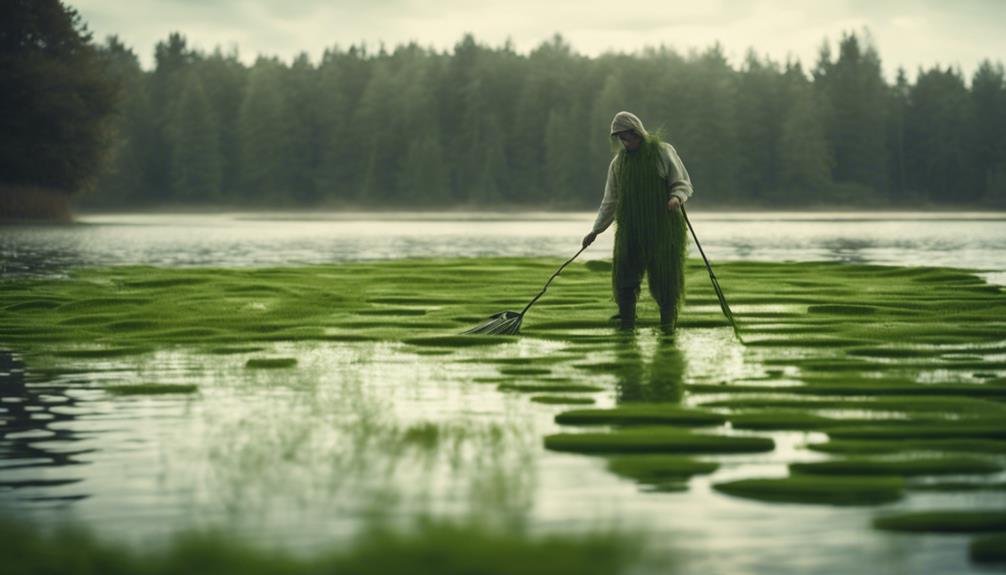
While maintaining a balanced ecosystem is vital, physically removing algae growth can provide a quick solution to control its spread, especially when combined with natural prevention methods.
As you take on this task, remember that prompt removal is necessary to remove the growth quickly and carefully to prevent string algae spores from being released.
Use a pond skimmer net: Remove filamentous algae growth using hands or a pond skimmer net to help control algae growth.
Cut it out: Using scissors to expedite removal of filamentous algae can be an effective method of physical removal.
Remove excess plant growth: Removing excess plant growth and composting it can help remove nutrients from the pond, which in turn can help control algae growth.
Keep in mind that physical removal is a temporary solution, and you'll need to address the underlying causes of algae growth to prevent its return.
Regular physical removal can be a time-consuming and labor-intensive process, but it can be an effective method when combined with other algae control strategies.
Types and Characteristics of Algae
Characterizing the different types of algae is essential to understanding their effects on your pond's ecosystem, as each variety exhibits distinct traits and growth patterns.
As you've probably noticed, algae often turn your pond's water green, but did you know there are different types responsible for this?
Planktonic algae, for instance, are microscopic and live throughout the water, causing it to appear green, brown, or reddish in color. These tiny organisms can grow rapidly in response to warm and sunny conditions, leading to sudden blooms. However, they usually disappear with the first frost, and your pond clears up quickly.
On the other hand, filamentous algae form long, unappealing strands that provide little value to your pond's ecosystem.
Blue-green algae, technically cyanobacteria, can cause unpleasant odors, unsightly surface scums, and even produce toxins that can harm animals and humans.
Managing Pond Ecosystem Balance

You can achieve a balanced pond ecosystem by maintaining a delicate balance between algae growth, aquatic plants, and nutrient levels, as excessive algae growth often indicates an imbalance in the ecosystem.
As a pond owner, crucially, you must manage this balance to maintain good water quality and prevent unsightly algae blooms.
Control nutrient levels: Reduce excess nutrients in the pond through regular water changes, de-silting, and buffering inflows. This will prevent algae blooms and maintain a balanced ecosystem.
Provide shade and introduce aquatic plants: Shade can limit algae growth, while aquatic plants like submerged plants absorb excess nutrients, competing with algae for resources.
Introduce grazing animals: Fish or ducks can graze on algae, helping to control its growth and maintain a balanced ecosystem.
Frequently Asked Questions
How to Stop Algae Growth in a Pond?
You can stop algae growth in your pond by implementing pond aeration to increase oxygen levels, installing UV clarifiers to eliminate algae spores, and maintaining a balanced ecosystem through regular water changes and aquatic plant management.
What Causes Excessive Growth of Algae in Ponds?
You're likely aware that a single algae cell can multiply to 1 million in just 24 hours! When your pond ecosystem is out of balance, a nutrient imbalance triggers excessive algae growth, often due to excess nutrients, overfeeding, or poor maintenance.
What Causes Excessive Algae Growth?
You investigate the factors contributing to excessive algae growth, focusing on Pond pH and Water Temperature, as ideal ranges for these parameters can prevent or promote algae blooms, ultimately affecting your aquatic ecosystem's balance.
What Does a Lot of Algae in a Pond Mean?
"Floating forests of filamentous flora fascinate you, but what does a lot of algae in a pond mean? It signals an imbalance in your pond ecosystem, threatening the delicate harmony of aquatic life, and you're the guardian to restore balance."
Conclusion
As you gaze out at your pond, remember that algae growth is a symptom, not the disease.
It's a warning sign that your pond's ecosystem is out of balance.
By addressing the underlying causes and implementing natural control methods, you can restore harmony to your aquatic environment.
Just as a gardener prunes a garden to promote healthy growth, you can prune your pond's ecosystem to allow its beauty to bloom.

